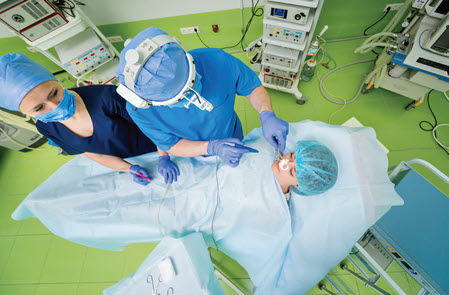Learn when it is, and is not, appropriate to report stent implantation.
A growing number of otolaryngologists are turning to drug-eluting stents (DES) to reduce polyps and the need for revision sinus surgery. Sinus implants like SINUVA® and PROPEL® are becoming increasingly common physician tools, as they have been proven to help expedite the healing process and avoid unwanted complications.
That’s why it’s more important than ever to make sure you’ve got a good grasp on the rules for coding the placement of SINUVA® and PROPEL® sinus implants. Read on for a breakdown of all the information you’ll need to understand DES implantation and find success when submitting these claims.

Skim This Synopsis
PROPEL® implants are typically inserted at the time of surgery to help keep the sinus open and gradually release a corticosteroid. Surgeons place them to reduce inflammation and scarring after ethmoid sinus surgery, thereby lessening the need for postoperative oral steroids and additional surgical interventions.
SINUVA® is a non-surgical, corticosteroid-eluting implant that is usually inserted in the office setting after the patient has undergone prior ethmoid sinus surgery. It is clinically proven to reduce polyps and the need for revision nasal surgery, as well as improve the symptoms of nasal polyps, nasal obstruction, congestion, and decreased sense of smell.
Further study: For more information about these implants, don’t forget to read “Keep Your Drug-Eluting Stent Know-How Current,” in this issue of Otolaryngology Coding Alert.
Context is crucial in understanding what to do when a provider decides to utilize a DES. Especially when it comes to billing for the sinus implantation procedure, as payers may consider the placement as an inclusive component of the surgery they are accompanying.
Understand Procedural Reporting Nuances
Otolaryngologists place these devices under direct endoscopic visualization. “Providers should report the CPT® code(s) which most accurately describes the services performed in association with the placement of a drug-eluting sinus implant,” advises Barbara J. Cobuzzi, MBA, CPC, COC, CPC-P, CPC-I, CENTC, CPCO, AAPC Fellow, of CRN Healthcare Solutions in Tinton Falls, New Jersey. Be mindful of what other procedures your ENT performs during the same session, however. Depending on the circumstances, you may not be able to report the placement of a PROPEL® or SINUVA® stent on the same claim as some procedures.
Secondary procedure – When placement of a DES occurs as an adjunct to an endoscopic sinus procedure (32131-31298), the work associated with implant placement is already included in the work relative value unit (RVU) calculation for the functional endoscopic sinus surgery (FESS) procedure code. Thus, you should only bill the CPT® code(s) relevant to the sinus procedure; do not report any additional codes to describe the work of the adjunct stent implantation.
Example: If your physician inserts a SINUVA® stent during a total intranasal ethmoidectomy, the insertion is included as part of the procedure and not separately coded. You would report CPT® 31255 (Nasal/sinus endoscopy, surgical with ethmoidectomy; total (anterior and posterior), and the facility would report the HCPCS Level II code for the sinus implant, J7402 (Mometasone furoate sinus implant, (sinuva), 10 micrograms). When the procedure is performed bilaterally, append modifier 50 (Bilateral procedure) to the CPT® code, except for code 31231 (which is already valued as a bilateral procedure).
Similarly, if the SINUVA® stent is inserted during a total ethmoidectomy and frontal sinusotomy (31253), a total ethmoidectomy and sphenoidotomy (31257), or a total ethmoidectomy and sphenoidotomy with removal of tissue from the sphenoid sinus (31259), you’d report the appropriate combination code for the FESS, and the facility would bill J7402 for DES. If the FESS is performed bilaterally, you’d append modifier 50 to the appropriate FESS code.
Stand-alone procedure following sinus surgery – When the placement of the DES is a separate procedure, and no other procedure is performed on that sinus during the encounter, you should report the work associated with implant placement. Submit CPT® code 31299 (Unlisted procedure, accessory sinuses), and be sure to include thorough documentation of your surgeon’s work and appropriate comparison information for reimbursement.
Coding tip: Because the unlisted codes don’t have valuations, you should always bill with a maximum of one unit of service. “While many procedures may involve a series of codes, known as component coding, the unlisted code is meant to encompass all of the additional procedures for which there is no CPT® code available to report,” explains Gregory Przybylski, MD, with JFK Medical Center, in Edison, New Jersey.

Don’t Forget to Crosswalk ‘Unlisted’
Whenever you submit an unlisted code, your challenge is to find a comparable procedure to use as a benchmark for workload and reimbursement. Let’s say you bill 31299 when your ENT places a PROPEL® Mini in the frontal sinus ostia postoperatively as a separate procedure; in this situation, 31231 (Nasal endoscopy, diagnostic, unilateral or bilateral (separate procedure)) or 31237 (Nasal/sinus endoscopy, surgical; with biopsy, polypectomy or debridement …) might be appropriate for either the ethmoid or frontal sinus. Your provider may be able to use these codes as a baseline and then add additional RVUs (supported by detailed documentation) when negotiating payment from the insurer.
Example: Putting a PROPEL® stent into the ethmoid sinus as a stand-alone procedure is coded with CPT® 31299. “You equate it to 31237 in Box 19” if debridement is done during placement. If the PROPEL® stents are put in bilaterally and a bilateral debridement is performed, equate it to 31237-50 in Box 19,” says Cobuzzi. If, however, your provider inserts the DES using diagnostic endoscopy, bilateral placement would not change the coding since 31231 is for unilateral or bilateral insertion.
Mind the global: “If the patient is in a global from a septoplasty (e.g., 30520 (Septoplasty or submucous resection, with or without cartilage scoring, contouring or replacement with graft)), which has a 90-day global, or an inferior turbinate radiofrequency procedure (e.g., 30802 (Ablation, soft tissue of inferior turbinates, unilateral or bilateral, any method … intramural (ie, submucosal))), which has a 10-day global, append modifier 58 (Staged or related procedure or service by the same physician … during the postoperative period) for staged procedure to 31299 and add the 58 to the codes that the 31299 is being equated to in Box 19, such as 31237-50-58,” Cobuzzi adds.
